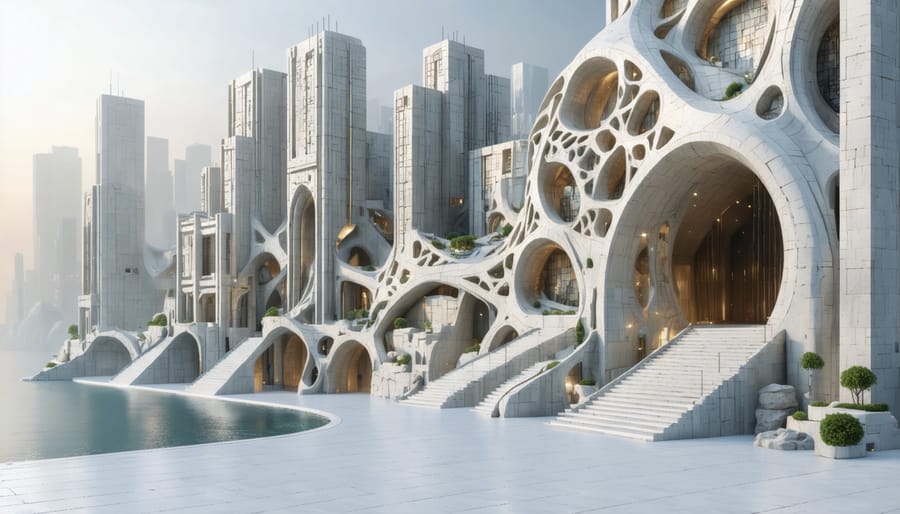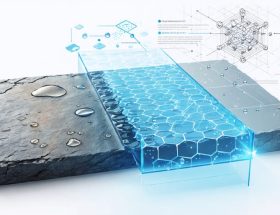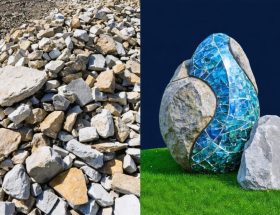Revolutionizing stone fabrication, 3D printing technology now enables architects and designers to create intricate stone structures previously impossible through traditional methods. This groundbreaking process combines ancient materials with modern precision, using specialized printers to deposit stone-based composites layer by layer, achieving remarkable detail and structural integrity.
Stone 3D printing marks a pivotal shift in construction and architectural design, offering unprecedented freedom to craft complex geometries while maintaining the natural beauty and durability of stone materials. From ornate architectural elements to custom-fitted stone fixtures, this innovation bridges the gap between digital design capabilities and physical stone craftsmanship.
Leading architecture firms worldwide are already implementing this technology to reduce waste, lower costs, and push the boundaries of what’s possible in stone construction. By merging the timeless appeal of natural stone with the precision of digital fabrication, 3D stone printing is setting new standards for sustainable, efficient, and creative architectural solutions.
How 3D Stone Printing Works
The Stone Printing Process
The stone printing process begins with material preparation, where natural stone powder is mixed with specific binding agents to create a printable composite. This mixture must achieve the right consistency – fluid enough to flow through the printer nozzle but stable enough to maintain its shape after extrusion.
The prepared stone material is loaded into the printer’s feeding system, which maintains consistent temperature and viscosity throughout the printing process. The 3D printer then follows a predetermined digital model, depositing the stone mixture layer by layer. Each layer typically ranges from 0.1 to 0.5 millimeters in thickness, depending on the desired resolution and structural requirements.
As each layer is deposited, the material begins to cure through either air-drying or UV-assisted hardening, depending on the binding agents used. The printer maintains precise control over extrusion speed, temperature, and movement to ensure uniform material distribution and proper layer adhesion.
Post-printing, the object undergoes a curing period, typically lasting 24-48 hours, allowing the binding agents to fully solidify. Some applications may require additional finishing steps, such as polishing or surface treatment, to achieve the desired aesthetic and durability characteristics.
The entire process requires careful monitoring of environmental conditions, including temperature and humidity, as these factors can significantly impact the final product’s quality and structural integrity.
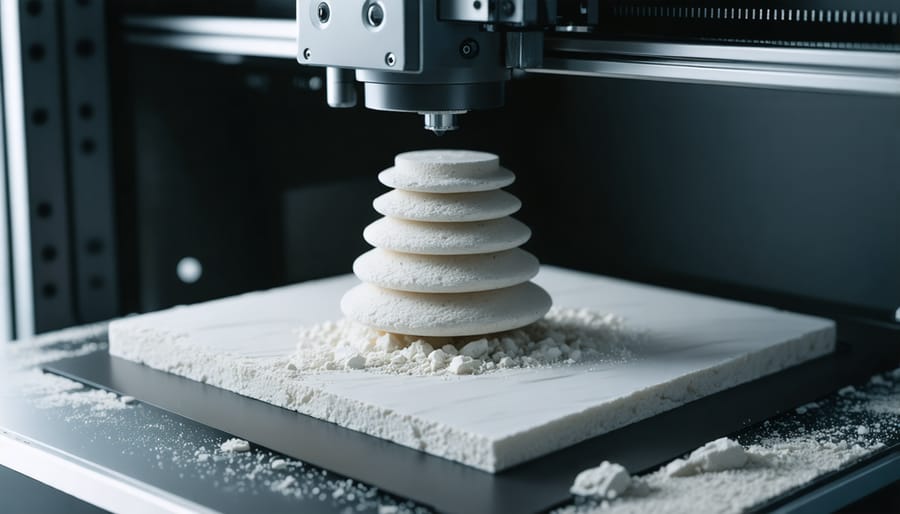
Materials and Binding Agents
The foundation of 3D stone printing lies in the careful selection and combination of stone materials in architecture with appropriate binding agents. The primary materials typically include limestone, granite, or marble powder, which are finely ground to specific particle sizes to ensure optimal printability. These stone particles are combined with proprietary binding agents, often consisting of specialized cements, polymers, or reactive additives that create strong bonds between the stone particles.
Common binding materials include Portland cement, geopolymers, and various organic and inorganic adhesives. The selection of binders depends on factors such as the desired strength, cure time, and final application of the printed object. Some formulations incorporate additives like silica fume or fly ash to enhance structural properties and workability.
The mixture ratio between stone particles and binding agents is crucial for successful printing. Too much binder can result in weak structures, while insufficient binding material may lead to poor layer adhesion. Most commercial stone printing materials contain 70-80% stone powder combined with 20-30% binding agents and additives.
Water content also plays a vital role in the printing process, affecting both flowability during extrusion and final strength. Modern formulations often include water-reducing agents and plasticizers to optimize the material’s behavior during printing while maintaining structural integrity in the finished product.
Applications in Modern Stone Fabrication
Architectural Elements
3D-printed stone has revolutionized contemporary architectural design, offering unprecedented possibilities for both decorative and structural elements. Architects and designers can now create intricate geometric patterns, custom-designed columns, and elaborate façade components that would be challenging or impossible to achieve through traditional stone fabrication methods.
The technology excels in producing detailed architectural elements such as cornices, capitals, and ornamental reliefs with exceptional precision. These components can be seamlessly integrated into both modern and historical restoration projects, maintaining aesthetic consistency while reducing installation time and material waste.
Structural applications include load-bearing elements like custom-designed support columns, archways, and wall systems. The precise nature of 3D printing allows for the creation of complex internal structures that optimize weight distribution while maintaining structural integrity. This capability has proven particularly valuable in creating lightweight yet durable building components that meet strict architectural specifications.
Decorative applications range from intricate wall textures and custom-designed water features to sculptural installations and unique interior design elements. The technology enables the production of perfectly matched stone components for large-scale projects, ensuring consistency in color, texture, and pattern across entire building facades.
The versatility of 3D-printed stone extends to creating modular building components that can be easily transported and assembled on-site. This approach has significantly reduced construction timelines while maintaining the authentic appearance and durability of natural stone. These innovations have made it possible to incorporate sophisticated stone elements into projects of all scales, from residential renovations to large commercial developments.
Custom Design Features
3D printing technology has revolutionized the way designers and architects approach custom stone elements, enabling the creation of intricate and unique features that were previously impossible or cost-prohibitive to produce. Contemporary projects showcase stunning examples of bespoke stone elements, from sculptural wall panels with complex geometric patterns to custom-designed fountains with organic flowing forms.
Architects are leveraging this technology to create signature architectural elements such as decorative column capitals, detailed cornices, and ornate facade components. These custom pieces can be designed with precise measurements and seamlessly integrated into both modern and historical restoration projects. Interior designers are incorporating 3D-printed stone features like textured accent walls, custom fireplace surrounds, and unique countertop designs that serve as dramatic focal points in residential and commercial spaces.
The technology excels in producing one-of-a-kind sculptural pieces, allowing artists to realize complex designs that would be challenging to achieve through traditional stone fabrication methods. Examples include abstract art installations, commemorative monuments, and decorative garden features with intricate detail work.
Landscape architects are utilizing 3D-printed stone to create custom outdoor elements such as water features, garden sculptures, and decorative pathway markers. These pieces can be designed to withstand outdoor conditions while maintaining their artistic integrity and structural stability.
Perhaps most impressively, 3D printing enables the recreation of historical architectural elements with exceptional accuracy. This capability has proven invaluable in restoration projects where original stone components have been damaged or lost, allowing for the precise replication of period-specific decorative elements while maintaining historical authenticity.
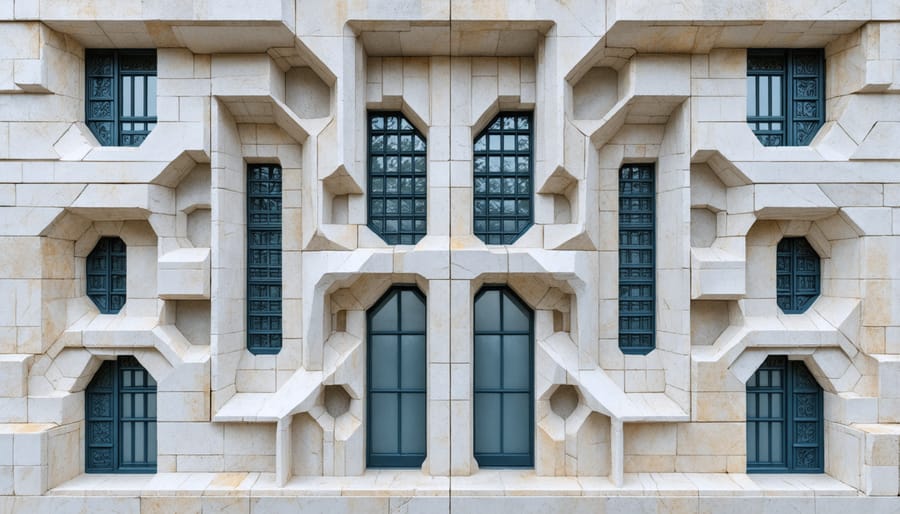
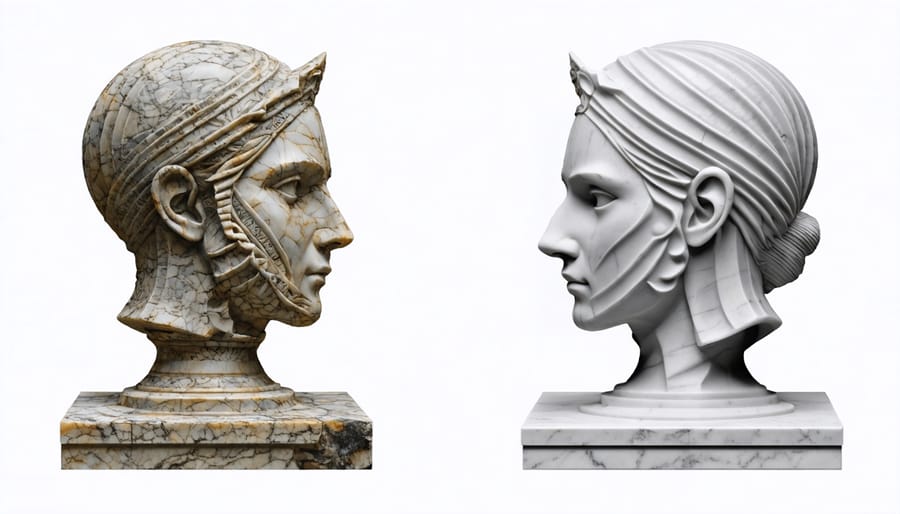
Advantages Over Traditional Stone Fabrication
Cost and Time Efficiency
3D printing technology in stone fabrication offers significant advantages in both cost reduction and time efficiency compared to traditional stone manufacturing methods. The automated process minimizes material waste by utilizing precise digital designs, typically reducing material loss by 30-40% compared to conventional cutting techniques.
Labor costs decrease substantially as a single operator can manage multiple 3D printers simultaneously, reducing the need for skilled stoneworkers for basic fabrication tasks. While the initial investment in 3D printing equipment is considerable, the long-term cost savings through reduced waste, labor, and improved efficiency often justify the expenditure within 2-3 years of operation.
Production speed increases dramatically with 3D stone printing. Complex architectural elements that traditionally required weeks of manual crafting can now be produced in days or even hours. For example, an ornate stone column that might take skilled artisans 2-3 weeks to create can be printed in approximately 24-36 hours with consistent quality.
The technology also enables rapid prototyping, allowing designers and architects to test multiple iterations quickly and cost-effectively before committing to full-scale production. This capability reduces expensive mistakes and streamlines the approval process with clients.
Additionally, the digital nature of 3D printing eliminates the need for extensive storage of physical templates and molds, reducing overhead costs and warehouse space requirements. The ability to print on-demand also helps manage inventory more efficiently, reducing capital tied up in stock materials.
Design Freedom and Complexity
3D printing technology has revolutionized stone fabrication by offering unprecedented design freedom and the ability to create complex geometries that would be challenging or impossible with traditional methods. Architects and designers can now realize intricate patterns, organic shapes, and detailed textures that previously existed only in their imagination.
The technology enables the creation of hollow structures, internal channels, and variable densities within a single piece – features that traditional stone cutting cannot achieve. These capabilities allow for innovative designs that combine aesthetic appeal with practical functionality, such as integrated cooling systems or lightweight yet sturdy structures.
Designers can experiment with parametric designs, creating mathematically precise patterns and structures that respond to specific environmental or functional requirements. The ability to rapidly prototype different iterations of a design helps optimize both form and function before final production.
Complex architectural elements like ornate cornices, detailed sculptural elements, and custom-fit stone panels can be produced with exceptional precision. The technology also allows for the seamless integration of different materials within a single piece, opening new possibilities for composite stone designs.
This design freedom extends to customization, where each piece can be unique without significant additional cost. Whether creating bespoke architectural features, artistic installations, or functional elements, 3D printing technology makes complex stone designs more accessible and commercially viable than ever before.
Real-World Success Stories
The architectural world has witnessed several groundbreaking projects showcasing the potential of 3D stone printing technology. In Barcelona, the Digital Stone Project created an intricately designed pavilion featuring complex geometric patterns that would have been impossible to achieve through traditional stone carving methods. The project reduced production time by 60% while maintaining the natural beauty of limestone.
Another remarkable example comes from the Netherlands, where a team of architects successfully printed a 12-foot-tall sculptural fountain using recycled marble powder. The project demonstrated both the sustainability aspects and the precise control offered by 3D stone printing, with water features seamlessly integrated into the structure’s organic curves.
In Dubai, the Museum of the Future incorporated 3D-printed stone elements in its façade design. The technology enabled the creation of precise Arabic calligraphy patterns embedded within the stone panels, combining traditional cultural elements with modern fabrication techniques. This project particularly highlighted the technology’s capability to handle intricate details while working with large-scale architectural elements.
The restoration industry has also embraced 3D stone printing. In Rome, conservators used the technology to recreate damaged portions of a 2nd-century marble sculpture. By scanning the intact sections and using matching stone material, they produced perfectly fitted replacement pieces that maintained historical accuracy while being clearly distinguishable from the original work.
A notable residential project in California showcased how 3D stone printing can revolutionize custom home design. The project featured printed limestone interior walls with embedded lighting channels and integrated storage solutions, demonstrating the technology’s versatility in creating functional yet aesthetically pleasing living spaces.
These success stories highlight how 3D stone printing is not just a theoretical concept but a practical solution delivering tangible results across various applications, from architectural elements to historical preservation and contemporary design.
3D stone printing represents a transformative advancement in construction and architectural design, bridging the gap between traditional craftsmanship and modern digital fabrication. As this technology continues to evolve, we’re witnessing its increasing adoption across various sectors, from heritage restoration to contemporary architecture and artistic expression.
The ability to create complex geometries and intricate designs while maintaining the authentic properties of natural stone opens up unprecedented possibilities for architects, designers, and builders. This technology not only reduces material waste and labor costs but also enables the creation of structures that would be impossible or impractical using traditional stone-cutting methods.
Looking ahead, the future of 3D stone printing appears promising. Ongoing research and development are focusing on improving print resolution, expanding material options, and increasing production efficiency. We can expect to see more sustainable practices emerge, as the technology enables better material utilization and reduced transportation needs through localized production.
The integration of artificial intelligence and machine learning with 3D stone printing systems suggests even more exciting possibilities, from automated optimization of structural designs to predictive maintenance of printed structures. As costs decrease and accessibility improves, this technology will likely become a standard tool in construction and design, revolutionizing how we work with one of humanity’s oldest building materials.
The marriage of traditional stone craftsmanship with digital innovation continues to push boundaries, promising a future where sustainable, beautiful, and complex stone structures become increasingly achievable and affordable.

